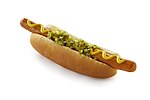Chavez Ravine
Elysian Park, Los AngelesHistory of Los AngelesMexican-American culture in Los AngelesSanta Monica Mountains

Chavez Ravine is a shallow L-shaped canyon in Los Angeles, California. It sits in a large promontory of hills north of downtown Los Angeles, next to Major League Baseball's Dodger Stadium. Chavez Ravine was named for Julian Chavez, a Los Angeles councilman in the 19th century who originally purchased the land in the Elysian Park area.
Excerpt from the Wikipedia article Chavez Ravine (License: CC BY-SA 3.0, Authors, Images).Chavez Ravine
Vin Scully Avenue, Los Angeles Elysian Park
Geographical coordinates (GPS) Address Phone number Website Nearby Places Show on map
Geographical coordinates (GPS)
| Latitude | Longitude |
|---|---|
| N 34.075 ° | E -118.239 ° |
Address
Dodger Stadium
Vin Scully Avenue 1000
90012 Los Angeles, Elysian Park
California, United States
Open on Google Maps






